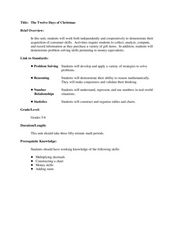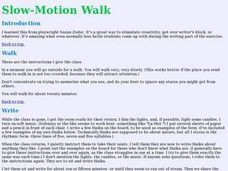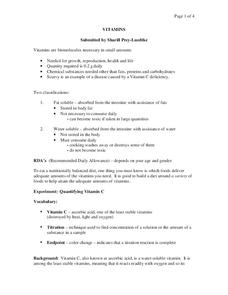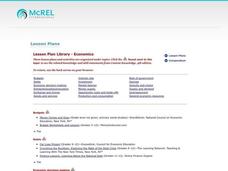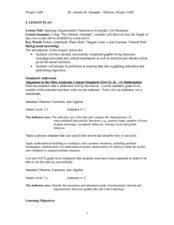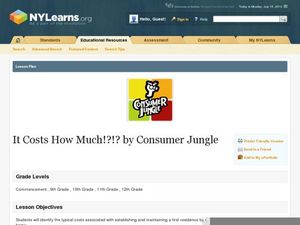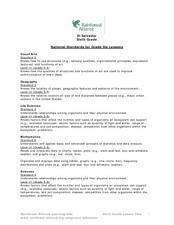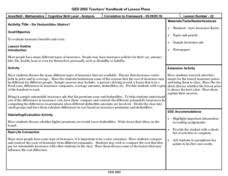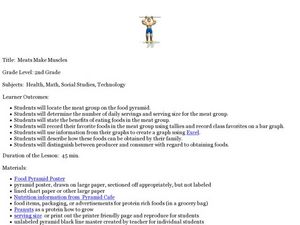Curated OER
Give and Take
Second graders are introduced to the differences between goods and services. In groups, they discover whether a given occupation offers a good, service or both. To end the lesson, they pick one occupation that interest them, draws a...
Curated OER
Acceptance Sampling
In this algebra lesson, students sample food and identify acceptance sampling. They create specific plans to meet specific situations as they sample the food. There are 6 questions.
Curated OER
The Twelve Days of Christmas
Pupils purchase gift items and practice collecting, analyzing, computing, and recording information. In this data lesson plan, students also complete money equivalent activities.
Curated OER
The Business of Credit
Learn about credit ratings and how it plays a role in the function of small businesses. Learners use their knowledge of good and bad credit to role play and determine good credit vs. bad credit in the area of small businesses.
Curated OER
Arranging Numbers from 1 to 5
Kindergarteners arrange manipulatives or everyday objects in groups of one through five. They identify groups seen in pictures of nature and compare same numbers of different objects.
Curated OER
Pacing a Gunther Chain
Students pace a Gunther Chain, a measurement used by foresters to determine distance and area. They discuss that pacing is individualized depending on age, gender, etc. They practice to find an average pace. Teams estimate, pace and...
Curated OER
What Time Does the Last Worker Report?
Third graders explore the concepts of time and consumer goods. In this telling time lesson, 3rd graders respond to questions about the passage of time and goods and services. This lesson incorporates the use a video titled...
Curated OER
Oceanography: Ocean Market
Sstudents identify consumer goods obtained from the oceans. They classify the items and calculate the cost of buying these goods. After taking a simulated sea shopping spree, they tally the cost of the items purchased. They conclude the...
Curated OER
Vitamins
High schoolers determine the amount of vitamin C present in 3 samples of juice stored in various light conditions. In this vitamin lesson plan, students investigate the amount of vitamin C present in juice exposed to different quantities...
Curated OER
Micro Economics - Personal Budgeting
Learners explore the real world as it relates to money and how people use it. In this money management lesson, students jump into the real world as they role play with money through spending, saving, being married, single, having...
Curated OER
Potato: A Tale from the Great Depression
Students barter for goods within the class. In this economics lesson based on the Great Depression, the teacher introduces the lesson with a picture book, then students are allowed to barter with teacher supplied goods as they examine...
Curated OER
Applying Trigonometric Functions To Real Life
Students examine where trigonometry exists outside the classroom. In this trigonometry lesson plan, students create trigonometric functions to match the data provided and to solve word problems relating to the real world.
Curated OER
Cookie Mining
Students start with $19 of Cookie Mining Money with which they must buy his/her own "mining property" or cookie. After cookies are bought, students give their "mine" a name, record it, along with the price of their cookie on the sheet.
PLS 3rd Learning
Reality Check Quiz
After conjuring up images of the ideal lifestyle, young adults are given a reality check. They take an online quiz and complete an activity that requires them to put their dream lifestyle in a real-world context. They determine how...
PLS 3rd Learning
It Costs How Much!?!?
Many teens conjure up images of how great their first apartment will be, but they lack a solid understanding of what it will cost to make it look that way. To gain an appreciation for the cost of furnishings, they create a collage of a...
Curated OER
El Salvador: Whose Breakfast Isn't for the Birds?
Sixth graders investigate the understanding of where coffee is grown by conducting a survey. They study the natural history of coffee and examine bird habitats in the areas where coffee is grown. They write letters to explaining the...
Teach Engineering
Photosynthesis—Life's Primary Energy Source
Wouldn't it be great if you could produce your own food? Scholars learn about the processes of photosynthesis and cellular respiration in plants. They consider how to use photosynthesis as a model of an efficient system and how to apply...
Curated OER
History of Toys and Games
Young scholars research history of popular toys to learn when those toys were first introduced. They use measurement skills to create an accurate timeline.
Curated OER
Swinging Pendulum
Learners engage in an activity which demonstrates how potential energy (PE) can be converted to kinetic energy (KE) and back again. Given a pendulum height, students calculate and predict how fast the pendulum will swing by understanding...
Visa
Credit Cards
Choosing your first credit card can often be an intimidating and confusing experience for young adults. Give your pupils the foundational knowledge they need for tackling this process head-on, including learning to...
Visa
In Trouble
What are some of the financial risks associated with using credit? Pupils learn the warning signs of incurring financial hardship, and through PowerPoint presentations, worksheets, and discussion, discover the...
Curated OER
Does My hair Disrupt Your Learning?
Students use the internet to research ways to save and earn money. They interview bankers and financial counselors to discover different types of investments. Students create public service announcements to inform their classmates of...
Curated OER
Do Deductibles Matter?
Fifth graders discuss insurance and the cost of automobile insurance. They compare and contrast the costs of insurance from different companies. They figure the savings from the lowest deductible to the highest deductible.
Curated OER
Meats Make Muscles
Second graders explore the meat group of the food pyramid. In this nutrition and diet lesson, 2nd graders study the benefits of eating foods in the meat group, collect data regarding their classmates' favorite foods, and create a graph...


